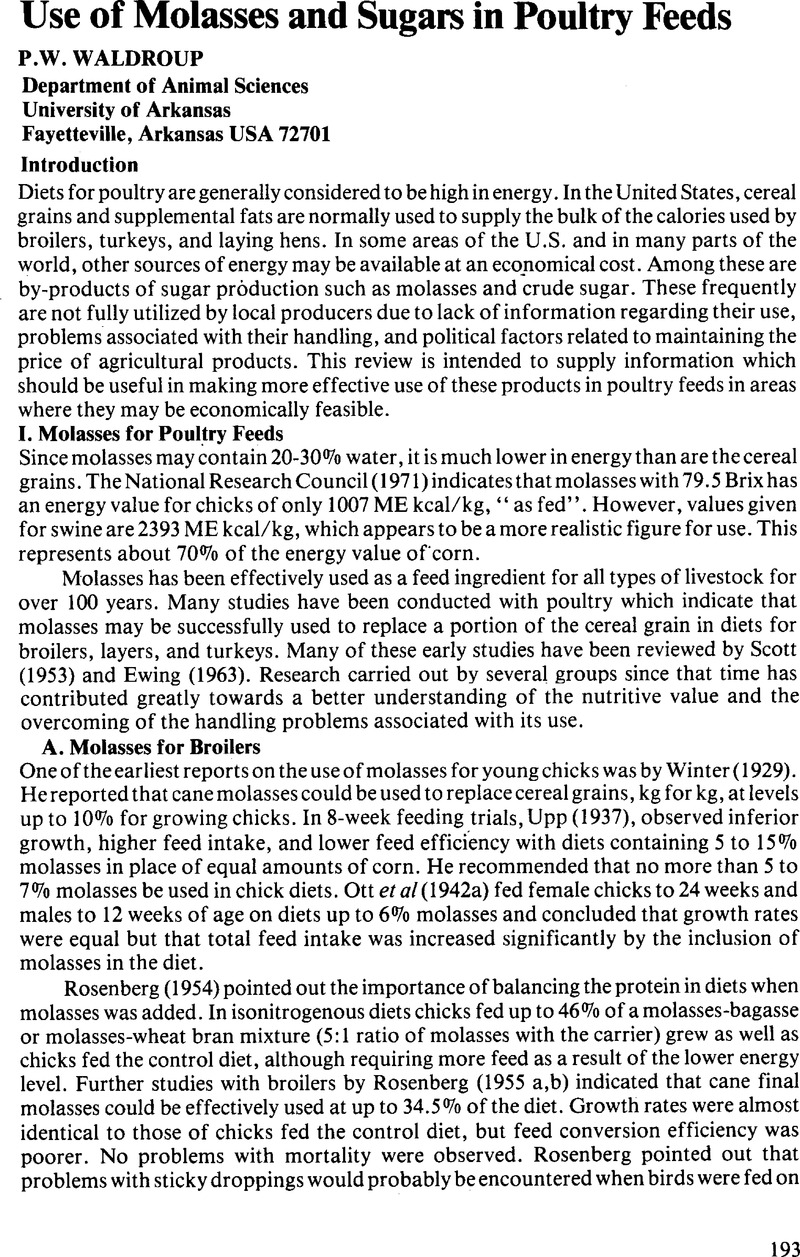Crossref Citations
This article has been cited by the following publications. This list is generated based on data provided by Crossref.
MILES, R.D.
CAMPBELL, D.R.
YATES, J.A.
and
WHITE, C.E.
1987.
Effect of Dietary Fructose on Broiler Chick Performance.
Poultry Science,
Vol. 66,
Issue. 7,
p.
1197.
Ravindran, V.
and
Blair, R.
1991.
Feed resources for poultry production in Asia and the Pacific region. I. Energy sources.
World's Poultry Science Journal,
Vol. 47,
Issue. 3,
p.
213.
Harland, J. I.
1993.
The Sugar Beet Crop.
p.
619.
Harland, Janice I.
Jones, Calvin K.
and
Hufford, Chuck
2006.
Sugar Beet.
p.
443.
Hashim, I.B.
Hussein, A.S.
and
Afifi, H.S.
2013.
Quality of breast and thigh meats when broilers are fed rations containing graded levels of sugar syrup.
Poultry Science,
Vol. 92,
Issue. 8,
p.
2195.
Wang, Lingyun
Nam, Sang-Ho
and
Lee, Manseung
2014.
Removal of Potassium from Molasses by Solvent Extraction and Ion Exchange.
Bulletin of the Korean Chemical Society,
Vol. 35,
Issue. 9,
p.
2711.
Hussein, Ahmed S.
Ayoub, Mostafa A.
Elhwetiy, Ahmed Y.
Ghurair, Jamal A.
Sulaiman, Mohsin
and
Habib, Hosam M.
2018.
Effect of dietary inclusion of sugar syrup on production performance, egg quality and blood biochemical parameters in laying hens.
Animal Nutrition,
Vol. 4,
Issue. 1,
p.
59.
Papizadeh, Moslem
Rohani, Mahdi
Nahrevanian, Hossein
Hosseini, Seyed Nezamedin
Shojaosadati, Seyed Abbas
and
Pourshafie, Mohammad Reza
2020.
Using Various Approaches of Design of Experiments for High Cell Density Production of the Functionally Probiotic Lactobacillus plantarum Strain RPR42 in a Cane Molasses-based Medium.
Current Microbiology,
Vol. 77,
Issue. 8,
p.
1756.
Selim, Shaimaa
Abdel-Megeid, Nazema S.
Abou-Elnaga, Manal K.
and
Mahmoud, Samy F.
2021.
Early Nutrition with Different Diets Composition versus Fasting on Immunity-Related Gene Expression and Histomorphology of Digestive and Lymphoid Organs of Layer-Type Chicks.
Animals,
Vol. 11,
Issue. 6,
p.
1568.
Zhang, Ning
Zhou, Yajie
Ali, Adnan
Wang, Tengyu
Wang, Xinfeng
and
Sun, Xinwen
2024.
Effect of Molasses Addition on the Fermentation Quality and Microbial Community during Mixed Microstorage of Seed Pumpkin Peel Residue and Sunflower Stalks.
Fermentation,
Vol. 10,
Issue. 6,
p.
314.


